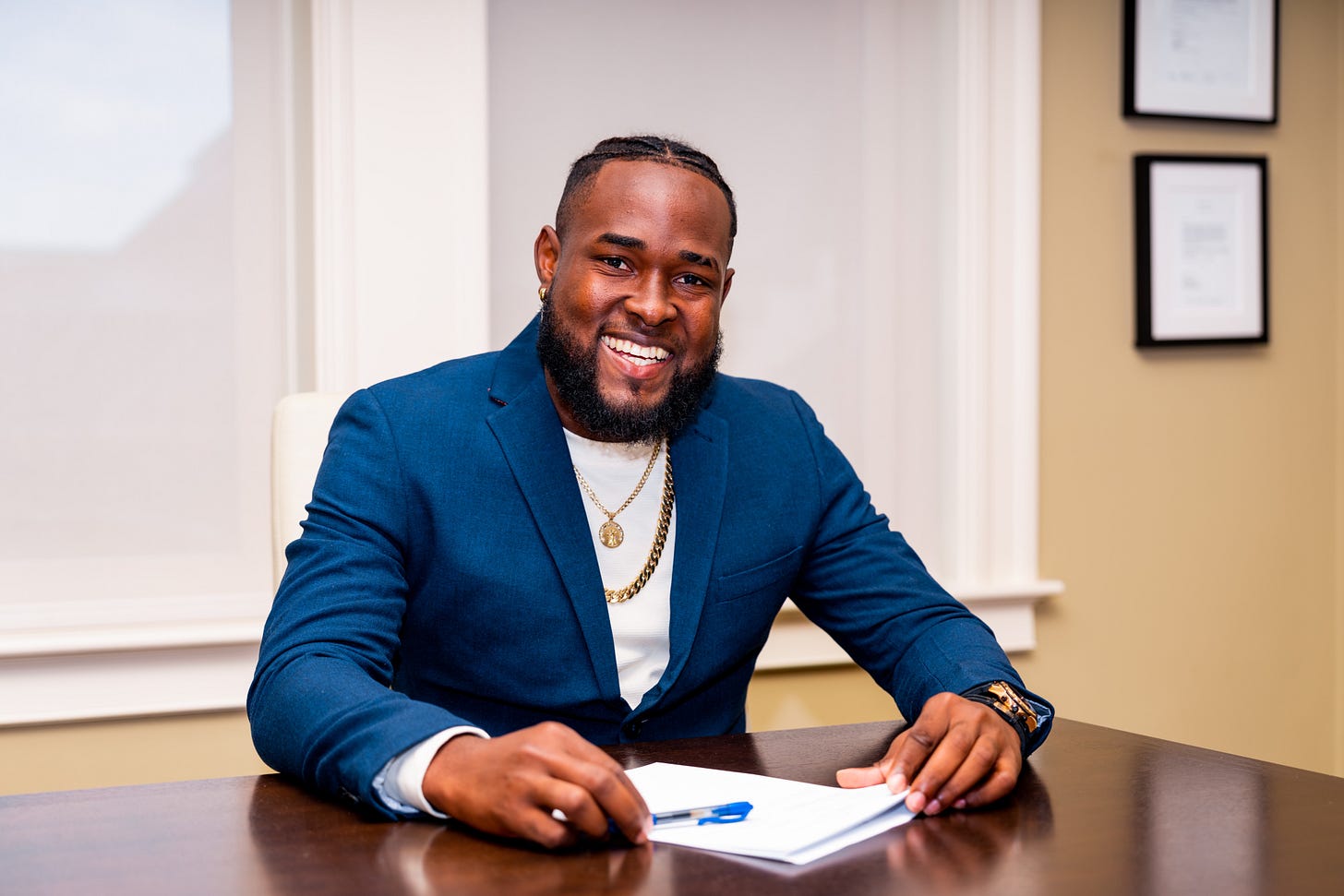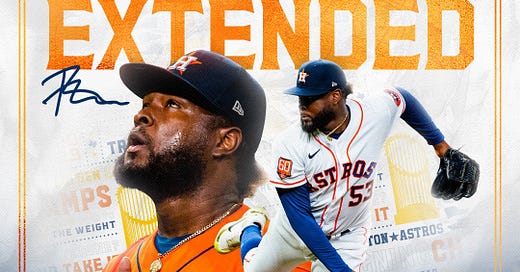Change...And More of the Same
Cristian Javier signs a similar extension to Alex Bregman & Yordan Alvarez. It reduces risk for the front office but still gives the player a chance to sign a second free agent contract later.
In March of 2019, Astros general manager Jeff Luhnow signed Alex Bregman—shortly before his first season of arbitration eligibility—to a 5-year extension which would cover his first two years of free agency.
In June of 2022, Astros general manager James Click signed Yordan Alvarez—shortly before his first season of arbitration eligibility—to a 6-year extension which would cover his first three years of free agency.
In February of 2023, Astros general manager Dana Brown signed Cristian Javier—shortly before his first season of arbitration eligibility—to a 5-year extension which would cover his first two years of free agency.
Three different GMs, but the exact same pattern—offer a star player an extension that covers their three arbitration seasons and a short number of free agent years. The team locks down a player for the next several seasons without taking a big risk on his long-term health and future. The player gets guaranteed money now, and the chance to go for free agency again before they get too old.
So the general manager may change, but the modus operadi stays the same. And thus, the biggest conclusion that we can draw from the Cristian Javier extension is the financial part of the Astros front office decision-making will not change much under Dana Brown.
Details on the Extension
Contract extensions for players who have arbitration eligibility left are always different than those for free agents, because players make less money in the years before they can enter the free market.
Jeff Passan provided the details on the yearly amounts that the Astros will pay Javier over the next five seasons.

The best way to think of these types of extensions is that they are in essence two contracts. The first is a three-year contract that settles the players salary rather than go through the arbitration process. This contract is for 3 years and $20 million. The second part covers the years in which the player is eligible for free agency. In this case, that is a 2 year contract worth $21 million a year.1
From a free agency standpoint, that's an excellent deal for the front office. The free agents this off-season who signed contracts for a similar annual salary are Chris Bassitt, who signed a 3 year/$21M per year contract with the Blue Jays and Martin Perez, who took a 1 year/$19.65M deal from the Rangers by accepting their "qualifying offer." And you’d rather have Javier on the mound this season than Bassitt or Perez.2

And in buying out only two years worth of free agency, the front office is reducing its risk. If Javier gets injured or is ineffective, they are only on the hook for two free agent seasons. And of course, those are the only two seasons of real risk in this deal. It is unlikely that Javier won’t be on the roster in the next three seasons regardless of any misfortune he suffers.
This is how the Astros front office has done extensions throughout Jim Crane’s ownership. The offer a player guaranteed money for a relatively short duration.
But there is one area where Javier clearly has an advantage in this contract. It ends after his age 30 season, allowing him to get another free agent contract near his prime years. And, as Anthony Franco of MLB Trade Rumors points out, Javier’s “stronger victory on the deal was in the absence of any club options at contract’s end.” The extensions signed bySandy Alcantara of the Marlines, Aaron Nola of the Phillies, and Carlos Martinez of the Cardinals—who were at a similar point to Javier on their service time clock—all included at least one club option year.
But again, this is standard practice for the Astros under Jim Crane, who did not negotiate an option year in the extensions they gave Bregman or Alvarez.
Javier the Pitcher
I wrote two articles during the last season about Javier. In late June, I wrote about how Javier had improved his command since the 2021 season.
Javier has improved his fastball mostly by improving his command of the pitch. Earlier this season, Cody Poage of The Crawfish Boxes noted how “there is noticeably better consistency in Javier’s horizontal release points this season compared to last…Establishing a more consistent release point, especially on the horizontal plane, has allowed Javier to improve his command.”
That improved command means that Javier is throwing his four-seam fastball more consistently in the strike zone. And by throwing it in the strike zone, he is generating more whiffs on the pitch; Javier has increased his whiff % on his four-seamer from 19.5% in 2020 to 26.2% this season.
And while Javier has put the ball in the strike zone more, he has not been hit hard for doing so. Opposing batters had a slugging percentage against Javier’s fastball of .442 in 2020 and .421 in 2021. In 2022, Javier has limited opposing hitters to a slugging percentage of .273.
Javier improved command in 2023 allowed him to take a full time job in the rotation after going back and forth between the bullpen and a starting job in 2020 and 2021. The contract extension indicates the front office thinks these improvements will sustain themselves.
In early November, I wrote more about the effectiveness of Javier’s fastball.
How does Javier get so many pop ups? A big reason is that the fastball that Javier throws has a great deal of “ride.” This used to be called a rising fastball before logic and high speed cameras ended that usage. But Javier’s fastball falls less quickly than that of the average pitcher, which makes batters feel that the ball “rises” as it nears the plate…
The Statcast numbers show that Javier has the 8th lowest amount vertical movement of any 4-seamer among major league pitchers. Among starting pitchers, Javier’s fastball ride ranks second behind Nestor Cortes.
Because the high spin on the ball keeps it from dropping as quickly as most pitchers, batters tend to swing under the fastball. Javier does not blow batters away with velocity. He fools them with deception. They cannot pick up the ball well enough to hit it on the barrel of their bat.
Improved command on a deceptive pitch makes it hard to hit. So it’s notable why I wrote about Javier on those two occasions. Both were written after he had thrown the opening (and longest) leg of the Astros two no-hitters last season—one against the Yankees (the AL’s highest scoring team last season) and one against the Phillies during the World Series.
It is obviously impressive to throw a no-hitter in the World Series, no matter when it is done. But it is even more impressive in the specific context of when Javier threw those 6 no-hit innings. Game 4 of the World Series was the one point of the post-season where the Astros were in actual jeopardy of losing a series. The team, built on starting pitching in 2022, had seen its rotation falter in bad starts from Justin Verlander in Game 1 and Lance McCullers in Game 3.
After Game 3, I wrote that the Astros “have 1 game to turn around the series.” Thanks primarily to Javier, they did.

Javier the Free Agent
The $21 million that Javier will earn in 2026 and 2027 puts him in line with a number of high level pitchers—though not with the top contracts for Cy Young contending pitchers.

The name that most stands out to me on that list is Luis Castillo. Castillo signed his own extension with the Mariners after being sent there in a trade last season. Castillo was only 1 year away from free agency, and he signed for $22.75M a year for his 4 free agent years. Javier had a similar year to Castillo in 2022 (Castillo had 4.1 bWAR; Javier 3.7), so one might think Javier would get a similar number in free agency.
The security of guaranteed money reduces the yearly amount, and it is likely that other pitchers will sign for larger yearly amounts between now and 2026.
But one of the key values for Javier in this contract is the ability to get into free agency after his age 31 season. The Astros may prefer short term deals, but that has value for players as well. They can sign another free agent contract before aging diminishes too much of their value.
The Future Risk is the Future’s Problem
And thus, the greatest risk that the front office runs in this extension to Javier. That Javier is as good as he was in 2022 (or better) throughout his contract and approaching its expiration in 2027. In such a circumstance, Javier will command a high salary in his next free agent negotiations. It’s certainly what Javier and his representatives hope for.
But of course, such a circumstance is actually pretty good for the front office. It presumes that they get more value out of Javier between now and then. It presumes that the improvements that we saw from Javier in 2022 stick in the near future. Of course, by guaranteeing him money in 2026 and 2027, it shows the front office thinks that will happen.
The real risk in this extension is in the future and thus, can be addressed in the future. Javier’s salary for the 2028 season does not have to be determined today. What can be addressed today is the fact that Javier will be a vital member of the team’s rotation in 2023, a team that is of course favored to return the playoffs again.
Javier will play a big role in the success of the Astros in 2023. And, after this contract, in 2024, 2025, 2026, and 2027.
I’m never sure what to do with the signing bonuses in these cases. I guess $1 million for each of the two parts.
The numbers bear this out. The ATC projections say that Javier will earn 2.9 fWAR in 2023, the 14th most in the AL. Bassitt is projected for 2.5 fWAR and Perez for 1.9.




